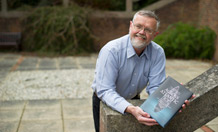Some of the earliest humans to inhabit America came from Europe according to a new book.
Across Atlantic Ice puts forward a compelling case for people from northern Spain travelling to America by boat, following the edge of a sea ice shelf that connected Europe and America during the last Ice Age, 14,000 to 25,000 years ago.
Across Atlantic Ice is the result of more than a decade’s research by leading archaeologists Professor Bruce Bradley of the University of Exeter and Dr Dennis Stanford of the Smithsonian Institution. Through archaeological evidence, they turn the long-held theory of the origins of New World populations on its head.
For more than 400 years, it has been claimed that people first entered America from Asia, via a land bridge that spanned the Bering Sea. We now know that some people did arrive via this route nearly 15,000 years ago, probably by both land and sea.
Eighty years ago, stone tools long believed to have been left by the first New World inhabitants were discovered in New Mexico and named Clovis. These distinctive Clovis stone tools are now dated around 12,000 years ago leading to the recognition that people preceded Clovis into the Americas.
No Clovis tools have been found in Alaska or Northeast Asia, but are concentrated in the south eastern United States. Groundbreaking discoveries from the east coast of North America are demonstrating that people who are believed to be Clovis ancestors arrived in this area no later than 18,450 years ago and possibly as early as 23,000 years ago, probably in boats from Europe. These early inhabitants made stone tools that differ in significant ways from the earliest stone tools known in Alaska. It now appears that people entering the New World arrived from more than one direction.
In their new book, the authors trace the origins of Clovis culture from the Solutrean people, who occupied northern Spain and France more than 20,000 years ago. They believe that these people went on to populate America’s east coast, eventually spreading at least as far as Venezuela in South America.
The link between Clovis and contemporary Native Americans is not yet clear. The authors do not suggest that the people from Europe were the only ancestors of modern Native Americans. They argue that it is evident that early inhabitants also arrived from Asia, into Alaska, populating America’s western coast. Their ongoing research suggests that the early history of the continent is far more intriguing than we formerly believed.
Some of the archaeological evidence analysed in the book was recovered from deep in the ocean. When the first people arrived in America, sea levels were nearly 130 metres lower than today. The shore lines of 20,000 years ago, which hold much of the evidence left by these early people, are now under the ocean. This is also the case in Europe.
Professor Bruce Bradley of Archaeology at the University of Exeter said: “We now have really solid evidence that people came from Europe to the New World around 20,000 years ago. Our findings represent a paradigm shift in the way we think about America’s early history. We are challenging a very deep-seated belief in how the New World was populated. The story is more intriguing and more complicated than we ever have imagined.”
Dr Dennis Stanford of the Smithsonian Institution agrees: “There are more alternatives than we think in archaeology and we need to have imagination and an open mind when we examine evidence to avoid being stuck in orthodoxy. This book is the result of more than a decade’s work, but it is just the beginning of our journey.”
Across Atlantic Ice is published by University California Press, Berkeley. It will be officially launched at the National Museum of Natural History, Smithsonian Institution, Washington DC, on 29 February 2012.
“Across Atlantic Ice is brilliant and ground-breaking. As fascinating as it is controversial, this book brings together decades of research from diverse areas into a single volume that is well argued, factually rich, elegantly written¬—and absolutely riveting. I could not put it down.” Douglas Preston, author of Cities of Gold, Thunderhead, and former archaeology correspondent for The New Yorker magazine
“In their well-written and well-reasoned exploration of the first inhabitants of the Americas, Dennis Stanford and Bruce Bradley have provided a viable alternative scenario. I am not a trained professional, but I have been reading the archaeological literature for thirty-five years. Their argument is logical and should be given an open-minded hearing.” Jean M. Auel, author of The Land of Painted Caves and The Clan of the Cave Bear.
“This carefully crafted, well-researched book aims to change our thinking of who the first Americans were and where they came from. Stanford and Bradley have produced an ambitious, interdisciplinary study of a neglected route of early entry into the Americas that will affect the way the larger narrative of the first chapter of human history in the New World is written.” Tom D. Dillehay, author of The Settlement of the Americas: A New Prehistory.
Listen to Professor Bruce Bradley discussing this research:
*Source: University of Exeter

